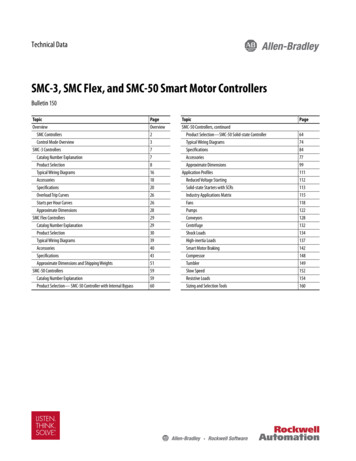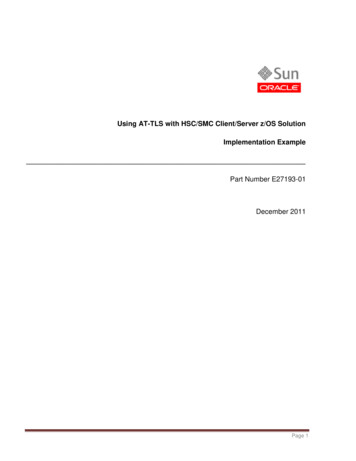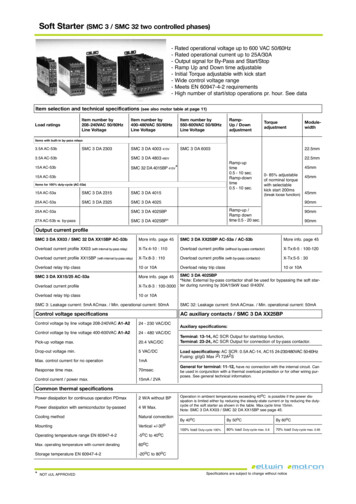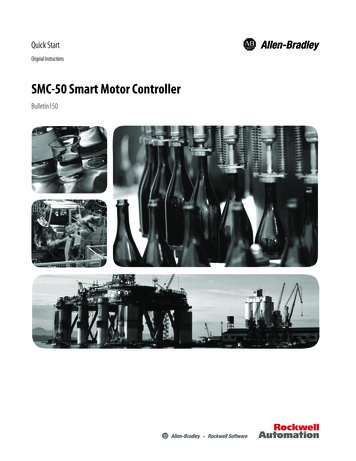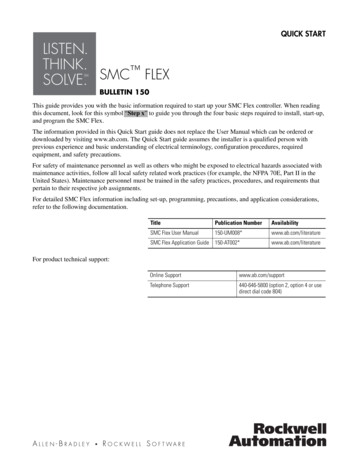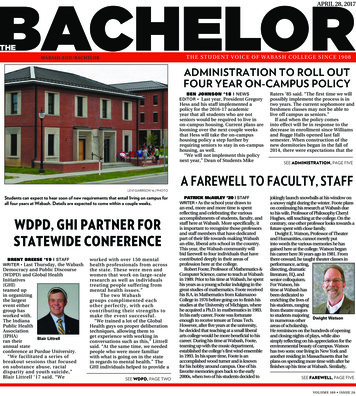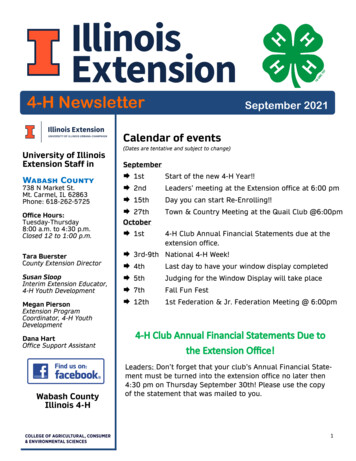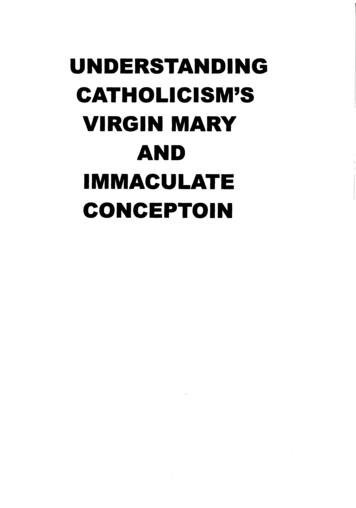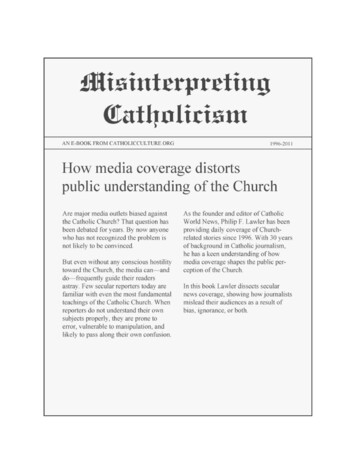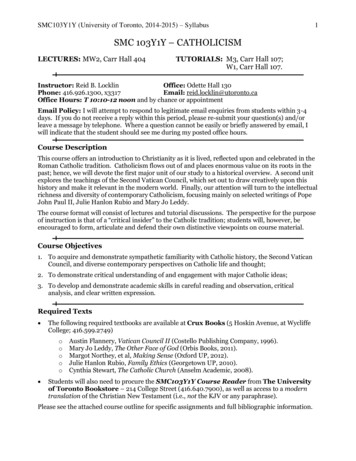
Transcription
SMC103Y1Y (University of Toronto, 2014-2015) – Syllabus1SMC 103Y1Y – CATHOLICISMLECTURES: MW2, Carr Hall 404TUTORIALS: M3, Carr Hall 107;W1, Carr Hall 107.Instructor: Reid B. LocklinOffice: Odette Hall 130Phone: 416.926.1300, x3317Email: reid.locklin@utoronto.caOffice Hours: T 10:10-12 noon and by chance or appointmentEmail Policy: I will attempt to respond to legitimate email enquiries from students within 3-4days. If you do not receive a reply within this period, please re-submit your question(s) and/orleave a message by telephone. Where a question cannot be easily or briefly answered by email, Iwill indicate that the student should see me during my posted office hours.Course DescriptionThis course offers an introduction to Christianity as it is lived, reflected upon and celebrated in theRoman Catholic tradition. Catholicism flows out of and places enormous value on its roots in thepast; hence, we will devote the first major unit of our study to a historical overview. A second unitexplores the teachings of the Second Vatican Council, which set out to draw creatively upon thishistory and make it relevant in the modern world. Finally, our attention will turn to the intellectualrichness and diversity of contemporary Catholicism, focusing mainly on selected writings of PopeJohn Paul II, Julie Hanlon Rubio and Mary Jo Leddy.The course format will consist of lectures and tutorial discussions. The perspective for the purposeof instruction is that of a “critical insider” to the Catholic tradition; students will, however, beencouraged to form, articulate and defend their own distinctive viewpoints on course material.Course Objectives1. To acquire and demonstrate sympathetic familiarity with Catholic history, the Second VaticanCouncil, and diverse contemporary perspectives on Catholic life and thought;2. To demonstrate critical understanding of and engagement with major Catholic ideas;3. To develop and demonstrate academic skills in careful reading and observation, criticalanalysis, and clear written expression.Required Texts The following required textbooks are available at Crux Books (5 Hoskin Avenue, at WycliffeCollege; 416.599.2749)ooooo Austin Flannery, Vatican Council II (Costello Publishing Company, 1996).Mary Jo Leddy, The Other Face of God (Orbis Books, 2011).Margot Northey, et al, Making Sense (Oxford UP, 2012).Julie Hanlon Rubio, Family Ethics (Georgetown UP, 2010).Cynthia Stewart, The Catholic Church (Anselm Academic, 2008).Students will also need to procure the SMC103Y1Y Course Reader from The Universityof Toronto Bookstore – 214 College Street (416.640.7900), as well as access to a moderntranslation of the Christian New Testament (i.e., not the KJV or any paraphrase).Please see the attached course outline for specific assignments and full bibliographic information.
SMC103Y1Y (University of Toronto, 2014-2015) – Syllabus2Assignments and Evaluation20% – Class Participation (attendance, contributions to class and/or tutorial discussions,Unmarked Quizzes, Co-Curricular Summaries, completion and presentation of 2 “lecture minutes,”proposal for Third Term Paper, and other short assignments, as specified by instructors). Termwork will not ordinarily receive letter grades, but will be assessed on -, , , basis (0 fornon-completion)—with a indicating adequate or satisfactory completion of the assignment.7.5% – First Term Paper (4-5 page Observation/Comparison), due 15 October 2014**Optional Rewrite, with required appointment with instructor, due 19 November 201412% – Second Term Paper (5-7 page Analysis/Argument), due 4 February 2015**Optional Peer Review process (required for first-year students), 9-23 January 201514% – Third Term Paper (5-7 page Interview/Synthesis), due 25 March 2015 Please note: late papers will be penalized by 2% for each day, or portion thereof, it is delayed(M-F). Papers will not ordinarily be accepted more than one week past the assigned deadline;papers delayed more than one week will receive a score of 0%.12.5% – Term Examination, Fall Examination Period (8-19 December 2014)34% – Comprehensive Final Examination, Winter Examination Period (8-30 April 2015)Marking protocols for tests and term papers will follow the Grading Regulations described on pp.699-700 of the University of Toronto Faculty of Arts and Science (St. George Campus) 2014-2015Calendar. NOTE: Failure to attempt every one of these written assignments (testsand term papers) will ordinarily result in failure of the course.Academic ExpectationsStudents are expected to attend lectures and tutorials regularly, to submit assignments on time,and to participate actively in class discussions. It is also expected that reading assignments will becompleted by the date and time of the tutorial. Excessive absences (i.e. more than two in a giventerm) and/or obvious lack of preparation will weigh against the participation portion of thestudent’s grade. Please set pagers, cell phones and portable devices to silent mode during class.Course materials and announcements will be posted on the Portal (i.e. the Blackboard AcademicSuite). Please make it a habit to check this site regularly. Please also request to join the SMC103Mentoring Network ref ts .All students in this class are bound by the Code of Behaviour on Academic Matters available at tionsandpolicies/academicintegrity.htm .Each individual student is responsible for completing her or his own work, for appropriatelyacknowledging outside sources used in the preparation of papers and other written work and foravoiding plagiarism or any other academic offence detailed in the Code. For more information onthe Code and suggestions on how to avoid an offence, please visit the Student Academic Integritywebsite (http://www.artsci.utoronto.ca/osai/students). To ensure the veracity of written work,students will submit all papers both to the instructor and to Turnitin.com, a commercial antiplagiarism service engaged by the University of Toronto.Please read the following notice very carefully: Normally, students will be required to submittheir course essays to Turnitin.com for a review of textual similarity and detection of possibleplagiarism. In doing so, students will allow their essays to be included as source documents in theTurnitin.com reference database, where they will be used solely for the purpose of detectingplagiarism. The terms that apply to the University's use of the Turnitin.com service are describedon the Turnitin.com web site.
2014-2015 COURSE OUTLINE FORSMC103Y1Y – CATHOLICISMInstructor: Reid B. Locklin, University of Toronto*Please note that more detailed guides for each month of the course, including readingquestions and recommendations for tutorial preparation, will be posted on Blackboard anddistributed in class.Reading assignments should generally be completed no later than the date and time of thetutorial on the week they are assigned (even if the tutorial session does not meet). Theseassignments may be subject to review and revision, as specified by the instructor.CR Course Reader, available from the U of T Bookstore (see syllabus)Fall Term 2014UNIT ONE: HISTORY AND TRADITION8-10 SeptemberJesus, the Kingdom of God and the Church Margot Northey, Bradford A. Anderson and Joel N. Lohr, Making Sense: A Student’sGuide to Research and Writing: Religious Studies (Don Mills, ON: Oxford University Press,2012), 1-20 (chs. 1-2). Cynthia Stewart, The Catholic Church: A Brief Popular History (Winona, MN: AnselmAcademic, 2008), 11-40 (chs. 1-2). Selections from Luke-Acts (Luke 1:1-4; 3:1-6, 15-17, 21-22; 4:14-30; 6:1-36; 8:1-3; 9:18-27;10:25-42; 22:1—24:53; Acts 1:1-26; 2:1-24, 36-43; 15:1-35). English trans.: New RevisedStandard Version Bible: Anglicized Edition (Division of Christian Education of the NationalCouncil of the Churches of Christ in the United States of America, 1989, 1995), OremusBible Browser, http://bible.oremus.org/; accessed 12 March 2005 [CR]. In Tutorials: Panel of Former Students, “Strategies to Succeed in SMC103”15-17 SeptemberGiving Shape to Catholic Identity and Life Due at the beginning of class 15 September: Unmarked Quiz #1 Northey, et al, Making Sense, 21-28 (ch. 3). Stewart, Catholic Church, 41-62 (ch. 3). Selections from the Apostle Paul (1 Corinthians 11:17—13:13; Romans 1:1-7, 16-17;11:13—12:18, 16:1-16). English trans.: New Revised Standard Version Bible: AnglicizedEdition (Division of Christian Education of the National Council of the Churches ofChrist in the United States of America, 1989, 1995), Oremus Bible Browser, accessed 31March 2005, http://bible.oremus.org/ [CR]. Continued on next page.
SMC103Y1Y (University of Toronto, 2014-15) – Course Outline2 The Didache #1, #5-16, in Michael W. Holmes, ed., The Apostolic Fathers: Greek Texts andEnglish Translations, rev. ed. (Grand Rapids: Baker Books, 1999), 251-53, 257-69 [CR]. Hippolytus of Rome, Apostolic Tradition #1-14, 20-25, in Geoffrey J. Cuming, ed.,Hippolytus: A Text for Students (Nottingham: Grove Books Limited, 1976, 1987), 8-15, 1724 [CR]. Selections from The Didascalia of the Apostles, in Lucien Diess, C.S.Sp., ed., Springtime ofthe Liturgy: Liturgical Texts of the First Four Centuries (Collegeville: Liturgical Press, 1979),167-80 [CR].22-24 SeptemberChurch, Empire and Christian Orthodoxy Northey, et al, Making Sense, 41-65 (ch. 5). Also recommended: Ibid., 98-122 (chs. 9-10). Matthew 28:16-20. NOTE: for this and future readings from the Christian scriptures, if you do not have yourown modern translation of the Christian Bible (e.g. NAB, NRSV, RSV, NJB, NIV), you canaccess the biblical texts online at one of the following addresses: New American Bible: http://www.usccb.org/nab/bible/ New Jerusalem Bible: http://www.catholic.org/bible/ Stewart, Catholic Church, 63-110 (chs. 4-5). Augustine of Hippo, Exposition of Psalm 61:5, in Expositions of the Psalms (51-72), trans.Maria Boulding, O.S.B., The Works of Saint Augustine III/17 (Hyde Park: New CityPress, 2001), 206-13 [CR]. Augustine of Hippo, Sermons 260A and 272, in Sermons (230-272B), trans. Edmund Hill,O.P., The Works of Saint Augustine III/7 (New Rochelle: New City Press, 1993), 187-91,300-301 [CR]. Term Paper 1 Workshop.29 Sep - 1 OctMonasticism and Religious Life Northey, et al, Making Sense, 35-39 (in ch. 4) & 153-61 (ch. 15). Recommended: Ibid., 170210 (chs. 16-18). Matthew 19:16-30. Stewart, Catholic Church, 94-95 (sidebar), 111-30 (ch. 6), 182-86 (in ch. 9). The Life of St. Mary of Egypt, in Benedicta Ward, S.L.G., Harlots of the Desert: A Study ofRepentance in Early Monastic Sources (Kalamazoo: Cistercian Publications, 1987), 35-56[CR]. Table of Contents and “Prologue,” The Rule of Saint Benedict, trans. Leonard Doyle(Collegeville, MN: Liturgical Press, 2001), v-ix, 13-20 [CR]. Francis of Assisi, “Canticle of the Sun” & “Testament” in Francis and Clare, ed. R.J.Armstrong and I.C. Brady (New York: Paulist Press, 1982), 37-39, 153-56 [CR].
SMC103Y1Y (University of Toronto, 2014-15) – Course Outline6-8 October3The Medieval Papacy Matthew 16:13-23. Review Stewart, Catholic Church, 128-29 (in ch. 6). Stewart, Catholic Church, 131-94 (chs. 7-9). Leo the Great, Excerpts from Sermons 4 & 5, in Robert B. Eno, S.S., ed., TeachingAuthority in the Early Church, Message of the Fathers of the Church 14 (Wilmington:Michael Glazier, 1984), 160-63 [CR]. Gregory VII, “Deposition of Henry IV” and “A Letter to the Bishop of Metz,” in HenryBettenson and Chris Maunder, eds., Documents of the Christian Church, 3d ed. (Oxford:Oxford UP, 1999), 113-21 [CR].13 OctoberTHANKSGIVING – NO CLASSES15 October(No tutorials)Highs and Lows of Papal Authority First Term Paper (Observation/Comparison) due at the beginning of class on Wednesday,15 October. Stewart, Catholic Church, 219-25 (in ch. 11). Boniface VIII, “Unam Sanctam,” in Henry Bettenson and Chris Maunder, eds., Documentsof the Christian Church, 3d ed. (Oxford: Oxford UP, 1999), 126-27 [CR]. Sally Wilkins, “Eastern Churches: How Are They Related to the Roman CatholicChurch?” Liguorian 88.4 (April 2000): 36 [CR].20-22 OctoberThomas Aquinas and the Medieval University Northey, et al, Making Sense, 147-52 (ch. 14). Romans 1:18-23. Stewart, Catholic Church, 195-216 (ch. 10). John W. O’Malley, “Were Medieval Universities Catholic?,” America, 14 May 2012,accessed 31 July 2012, ?articleid 13417 [CR]. Josef Pieper, A Guide to Thomas Aquinas (New York: Pantheon Books, 1962), 118-33 [CR]. Thomas Aquinas, Questions 1.1.1, 3a.1.1, and 3a.75.1-2, in Summa Theologiae, vol. 1, trans.Thomas Gilby, vol. 48, trans. R.J. Hennessey, and vol. 58, trans. William Barden (NewYork: McGraw-Hill, 1964-76) [CR].
SMC103Y1Y (University of Toronto, 2014-15) – Course Outline27-29 October4Protestant and Catholic Reformations Galatians 2:15-21 & James 2:14-26. Stewart, Catholic Church, 217-41 (ch. 11). Martin Luther, Excerpts from 2 treatises of 1520 and final statement before the Diet ofWorms in Henry Bettenson and Chris Maunder, eds., Documents of the Christian Church,3d ed. (Oxford: Oxford UP, 1999), 213-24 [CR]. Selections from Canons and Decrees of the Council of Trent, ed. H.J. Schroeder (St. Louis: B.Herder, 1941), 51-54, 72-80, 144-50, 160-63 [CR].3-5 NovemberNew Worlds and Rival Views Northey, et al, Making Sense, 98-106 (ch. 9). Acts 17:16-31 & Luke 22:31-32. Stewart, Catholic Church, 242-78 (chs. 12-13). Roberto De Nobili, S.J., Excerpts from “What Rule Should Guide Us in Admitting andJudiciously Deciding about India’s Social Customs,” in Preaching Wisdom to the Wise:Three Treatises, trans. Anand Amaladass, S.J. and Francis X. Clooney, S.J. (St. Louis: TheInstitute of Jesuit Sources, 2000), 195-96, 210-15 [CR]. Vatican I, Pastor Aeternus in Documents of Vatican Council I: 1869-1870, ed. F.J. Broderick(Collegeville: Liturgical Press, 1971), 53-63 [CR].10-12 NovemberFrom Vatican I to Vatican II Deadline for appointments and rewrite proposals (to qualify for a rewrite): 12 November. Northey, et al, Making Sense, 107-22 (ch. 10). John 16:12-15. Stewart, Catholic Church, 278-307 (chs. 13-14). David L. Edwards, “Catholicism as Development,” in Christianity: The First TwoThousand Years (Maryknoll: Orbis Books, 1997), 405-8 [CR]. Selections from John Henry Cardinal Newman, Essay on the Development of ChristianDoctrine, in The Essential Newman, ed. Vincent Ferrer Blehl (New York: New AmericanLibrary, 1963), 118-33, 136-38 [CR]. Pope John XXIII, “Opening Address,” in Walter M. Abbott, ed., The Documents of VaticanII (New York: Guild Press., 1966), 710-19 [CR].17 NovemberREADING PERIOD – NO CLASS
SMC103Y1Y (University of Toronto, 2014-15) – Course Outline5UNIT TWO: THE SECOND VATICAN COUNCIL19 November(No tutorials)The Mystery of the Church Optional Rewrite of First Term Paper due at the beginning of class on Wednesday, 19November (only for students who have qualified with a proposal and appointment). Daniel Donovan, “Vatican II—Renewing the Church,” in The Church as Idea and Fact(Wilmington: Michael Glazier, 1988), 27-43 [CR]. Vatican II, “Constitution on the Sacred Liturgy” (Sacrosanctum Concilium), introduction(#1-4), and ch.1, sections II & III.A-C (#14-36), in Vatican Council II: A Completely RevisedTranslation in Inclusive Language, ed. Austin Flannery, O.P. (New York: CostelloPublishing Company, 1996), 117-18, 124-31. Vatican II, “Dogmatic Constitution on the Church (Lumen Gentium),” ch. 1 (#1-8), inFlannery, Vatican Council II, 1-11.24-26 NovemberThe People of God Note: the deadline for submitting the first Co-Curricular Summary is Friday, 28November. Northey, et al, Making Sense, 123-32 (ch. 11). Vatican II, “Dogmatic Constitution on the Church (Lumen Gentium),” chs. 2-3 (#9-29) andch. 4 (#37 only) in Flannery, Vatican Council II, 12-47, 56-57. Joseph Cardinal Ratzinger, “The Ecclesiology of the Second Vatican Council,” in Church,Ecumenism and Politics: New Essays in Ecclesiology (New York: Crossroad, 1988), 3-20[CR].1-3 December(No tutorials)Revelation and Sacred Scripture Vatican II, “Dogmatic Constitution on Divine Revelation (Dei Verbum),” prologue andchs. 1-3 (#1-13) in Flannery, Vatican Council II, 97-107. Richard R. Gaillardetz, “Vatican II’s Theology of Revelation,” in By What Authority? APrimer on Scripture, the Magisterium, and the Sense of the Faithful (Collegeville: LiturgicalPress, 2003), 1-11 [CR]. Review for Term Examination.8-19 DecemberTerm Examination on the date and time setby the Registrar for the Faculty of Arts and Science
SMC103Y1Y (University of Toronto, 2014-15) – Course Outline6Winter Term 20155-7 JanuaryChurch, World and World Religions Deadline to request peer review (required for first-year students): 1:00 pm on Friday, 9January. Northey, et al, Making Sense, 81-97 (ch. 8). Vatican II, “Pastoral Constitution on the Church in the Modern World (Gaudium etSpes),” Preface (#1-3) and Part One, Chapter 4 (#40-45), in Flannery, Vatican Council II,163-5, 206-17. Vatican II, “Declaration on Religious Liberty (Dignitatis Humanae)” and “Declaration onthe Relation of the Church to Non-Christian Religions (Nostra Aetate),” in Flannery,Vatican Council II, 551-74. Karl Rahner, “Toward a Fundamental Theological Interpretation of Vatican II,”Theological Studies 40 (1979), 716-27 [CR]. In Tutorials: Drafting, Reviewing and Revising Academic Writing12-14 JanuaryA Pilgrim Church Draft of Second Term Paper posted electronically no later than 1:00 pm on Friday, 16January (for those participating in peer review). Recommended: Review Northey, et al, Making Sense, 41-65 (ch. 5) & 107-22 (ch. 10). Vatican II, “Dogmatic Constitution on the Church (Lumen Gentium),” ch. 7 (#48-51), inFlannery, Vatican Council II, 72-79. Dennis Doyle, “Pilgrims and Saints,” in The Church Emerging from Vatican II: A PopularApproach to Contemporary Catholicism, rev. ed. (Mystic: Twenty-Third Publications, 2002),211-18. Avery Dulles, S.J., “Vatican II: The Myth and the Reality,” America 188 (24 February2003), 7-11 [CR]. John O’Malley, “The Style of Vatican II,” America 188 (24 February 2003), 12-15 [CR].
SMC103Y1Y (University of Toronto, 2014-15) – Course Outline7UNIT THREE: CONTEMPORARY CATHOLICISM – VISIONS AND VIEWS19-21 JanuaryPope John Paul II: Faith and Ethics for the Third Millennium Peer reviews of Second Term Paper due no later than 1:00 pm on Friday, 23 January (forthose participating in peer review). Vatican II, “Dogmatic Constitution on Divine Revelation (Dei Verbum),” ch. 2 (#7-10), inFlannery, Vatican Council II, 100-104. Stewart, Catholic Church, 308-29 (ch. 15). Pope John Paul II, “Encyclical Letter ‘Redemptor hominis’” #1-17, The Holy See, accessed10 June 2010, http://www.vatican.va/holy father/john paul ii/encyclicals/documents/hf jp-ii enc 04031979 redemptor-hominis en.html [CR].26-28 JanuaryBuilding a Better World Vatican II, Gaudium et Spes #24-26, in Flannery, Vatican Council II, 189-92. Edward P. DeBerri, James E. Hug, with Peter J. Henriot and Michael J. Schultheis, “TheSocial Concerns of the Church,” in Catholic Social Teaching: Our Best Kept Secret, 4th ed.(Maryknoll and Washington, D.C.: Orbis Books and the Center of Concern, 2003), 88-95[CR]. Chapters 4-6 (#27-45) of Pope John Paul II, “On Concern for the Social Order (SollicitudoRei Socialis),” Origins 17 (3 March 1988), 650-57 [CR]. Gregory Baum, “The Preferential Option for the Poor,” in Amazing Church: A CatholicTheologian Remembers a Half-Century of Change (Ottawa: Novalis, 2005), 53-82 [CR].2-4 February(No tutorials)Conscience, Freedom and a Culture of Life Second Term Paper (Analysis/Argument) due at the beginning of class on Wednesday, 4February. Northey, et al, Making Sense, 29-40 (ch. 4). Vatican II, Gaudium et Spes #15-17, in Flannery, Vatican Council II, 177-79. Edward P. DeBerri, James E. Hug, with Peter J. Henriot and Michael J. Schultheis, “TheGospel of Life,” in Catholic Social Teaching: Our Best Kept Secret, 4th ed. (Maryknoll andWashington, D.C.: Orbis Books and the Center of Concern, 2003), 120-24 [CR]. Introduction and Chapter 1 (#1-28) of Pope John Paul II, “Encyclical Evangelium Vitae,”Origins 24 (6 April 1995), 689-700 [CR]. Dennis M. Doyle, “Levels of Teaching, Levels of Assent,” in The Church Emerging fromVatican II: A Popular Approach to Contemporary Catholicism, rev. ed. (Mystic: Twenty-ThirdPublications, 2002), 102-11 [CR].
SMC103Y1Y (University of Toronto, 2014-15) – Course Outline9-11 February8The “New Feminism” of John Paul II Driscoll, Dana Lynn, and Allen Brizee, “What is Primary Research and How Do I GetStarted?” OWL: Perdue Online Writing Lab, http://owl.english.purdue.edu/owl/owlprint/559/ [Electronic Resource]. Vatican II, Gaudium et Spes #27-29, in Flannery, Vatican Council II, 192-95. Pope John Paul II, “Letter to Women,” Origins 25 (27 July 1995), 137-43 [CR]. Pope John Paul II, “Women: Teachers of Peace,” EWTN Global CommunicationsLibrary: The Pontificate of Pope John Paul II, accessed 6 July C.htm, [CR]. Pope John Paul II, “Enhance Women’s Role in Church Life,” EWTN GlobalCommunications Library: The Pontificate of Pope John Paul II, accessed 6 July .HTM [CR]. Cathleen Kaveny, “The ‘New’ Feminism? John Paul II & the 1912 Encyclopedia,”Commonweal, 28 March 2008, 8 [CR]. M. Cathleen Kaveny, “Defining Feminism: Can the Church and the World Agree on theRole of Women?,” America, 28 February 2011, 14-17 [CR].16-18 FebruaryREADING WEEK – NO CLASSES23-25 FebruaryJulie Hanlon Rubio: Moral Striving in Ordinary Life Vatican II, “Dogmatic Constitution on the Church (Lumen Gentium),” #32-35, inFlannery, Vatican Council II, 49-54. Julie Hanlon Rubio, Family Ethics: Practices for Christians (Washington, DC: GeorgetownUniversity Press, 2010), 1-65 (intro and chs. 1-2). Marc Cardinal Ouellet, “Theological Perspectives on Marriage,” Communio: InternationalCatholic Review 31 (2004): 419-34 [CR]. Interview/Term Paper 3 Workshop (in tutorials).2-4 MarchChristian Families and Human Sexuality Proposal for Third Term Paper (Interview/Synthesis) due at the beginning of class onMonday, 2 March. Vatican II, “Pastoral Constitution on the Church in the Modern World (Gaudium etSpes),” #47-50, in Flannery, Vatican Council II, 218-24. Rubio, Family Ethics, 66-127 (chs. 3-4). Luke Timothy Johnson and Eve Tushnet, “Homosexuality and the Church: Two Views,”Commonweal 134 (15 June 2007): 14-21 [CR]. Recommended: Rubio, 164-89 (ch. 6).
SMC103Y1Y (University of Toronto, 2014-15) – Course Outline9-11 March9The Family Meal and the Heavenly Banquet Vatican II, “Dogmatic Constitution on the Sacred Liturgy (Sacrosanctum Concilium)” #910, in Flannery, Vatican Council II, 122-23. Rubio, Family Ethics, 128-63, 214-44 (chs. 5, 8 and Conclusion). Amy Welborn, “Why Go to Mass?” First Things 86 (August/September 1998), 23-25[CR]. Recommended: Rubio, Family Ethics, 190-213 (ch. 7).16-18 MarchMary Jo Leddy: The Face of the Stranger Vatican II, Gaudium et Spes #53-59, in Flannery, Vatican Council II, 229-36. Mary Jo Leddy, The Other Face of God: When the Stranger Calls Us Home (Maryknoll, NY:Orbis Books, 2011), 1-55 (Introduction & chs. 1-2).23-25 March(No tutorials)Power in the Neighbourhood Third Term Paper (Interview/Synthesis) due at the beginning of class on Wednesday, 25March. Leddy, Other Face, 56-107 (chs. 3-5).30 Mar – Apr 1Christ In-Between and Among Note: the deadline for submitting the second Co-Curricular Summary is Friday, 3 April. Leddy, Other Face, 108-39 (chs. 6-7). Pope Francis, “Homily of Pope Francis, Visit to Lampedusa,” 8 July 2013, The Holy See,accessed 17 July 2013, http://www.vatican.va/holy cesco 20130708 omelia-lampedusa en.html [CR]. Review for Final Examination.8-30 AprilComprehensive Final Examination on the date and timeset by the Registrar for the Faculty of Arts and Science
SMC103Y1Y – LocklinWhat on earth are “Lecture Minutes”?We all learn in a variety of ways: we readcarefully, we listen to others, and the like.Many educational theorists argue,however, that the most successful learningstrategies involve some level of“rehearsal”—that is, re-presenting coursecontent in our own words.To a certain extent, such “rehearsal” isinvolved in tutorial discussions, termpapers, and even tests. In this class,however, students will also re-presentlecture material in “minutes” or shortsummaries presented in class thefollowing lecture session.Every student will prepare lectureminutes for one lecture each term. In thefirst term, students will work in teams of2-3. These teams will meet betweenlectures, prepare a single “lectureminutes” text in both written andelectronic form, and choose one amongtheir number to present it orally at thebeginning of the next lecture session—please note: all members of the team willreceive the same mark for the first lectureminutes assignment. In the second term,2-3 students will each prepare their ownlecture minutes, and they will decidebetween them who will present her or histext to the class. In both terms, minuteswill be handed in (in print and electronicforms) to be evaluated as part of students’class participation scores and to be postedon the course web-page.Minutes should be between 290 and 330words in length, or approximately onepage, double-spaced, in a standard 12point font. The presentation should takeno longer than 5 minutes. See theexample on the facing column.Sample lecture minutes (from SMC216):5 December 2006On Tuesday, Michael O’Connor offered a guestlecture on the topic of early Christian hymnody.Drawing on the eighteenth-century Methodist JohnWesley, Dr. O’Connor advanced the thesis that, farfrom being mere “icing,” Christian hymnsrepresent a way of presenting biblical teaching thatis both pleasurable and profitable.Unfortunately, we know relatively little abouthow and what the earliest Christians sang. TheOxyrhynchus hymn, a third-century fragment,offers a few lines of text and some notations, butno indication of performance practice. It is asedate hymn with relatively few notes and a simpletext. The very simplicity of such music made it apowerful instrument in the various “battles overorthodoxy” in the early centuries of the church:rival groups would organize themselves withchants or rhymes that offered short statements offaith. For this reason, a Synod of Laodicea ruled in320 CE that private individuals should no longercompose hymns at all; instead, with the exceptionof such hymns as the “Sanctus” (incorporated intothe anaphora), churches should only use texts fromthe canonical scriptures—especially the Psalms—in worship. Precisely because music has a uniquepower to bring things to life, it must be treatedwith caution.A more enthusiastic view is represented byAmbrose of Milan (340-397). He wrote metricalhymns in strophic form—that is, with repeatedstanzas. Many were composed to honour momentsof the day in connection to Christ’s life andpassion. All these hymns ended with a doxology,which was also a confession of orthodox faith inthe Trinity. On one occasion, in fact, whenAmbrose’s church came under siege by a groupsympathetic to Arianism, the congregation joinedin song “after the manner of the Eastern Church”to strengthen themselves and resist their captors.Lecture concluded with the ambivalent positionof Augustine of Hippo (354-430), who approved ofsinging hymns but feared that the pleasure of themusic might distract singers from the meaning ofthe words.[Prepared by: R. Locklin, 327 words]
SMC103Y1Y – LocklinCo-Curricular Summaries for SMC 103As valuable as the time we spend together in class may be, the university experience alsoprovides other avenues for students to acquire academic skills and to indulge the life of themind. To reflect this fact, students in this class are required to attend and summarize at leasttwo co-curricular events during the academic year (replacing three tutorial meetings in theacademic schedule). One of these summaries must be submitted no later than 28 November2014; the second must be submitted no later than 3 April. Both may be completed in the fallterm, if desired.Additional events (up to four total, throughout the academic year) may also be summarized forextra-credit in the student’s class participation mark.What kind of event should I attend?If you are a first-year student, you are required to attend two academic skills workshopssponsored by the Research and Academic Skills Center (RASC) and/or the Mentoring andAcademic Peer Programme. Check the RASC website for more details: v tab3 . If you would prefer to attendan equivalent programme at another Faculty or College, please consult with the instructorbeforehand to verify its eligibility.If you are a second-, third- or fourth-year student, you are required to attend two public lectures orother academic events on the University of St. Michael’s College campus – on any topic youchoose. Events will be announced in class and are also updated regularly on the USMC eventspage http://stmikes.utoronto.ca/events/default.asp .These restrictions apply only to the two required co-curricular summaries. Students of any yearmay attend either RASC workshops or academic events for extra credit.How do I claim credit for the events I attend?Students may claim credit in one of two ways:First, students may submit a 100-150 word summary within two weeks of the event, stating thename, place, date and time of the event, summarising the main argument of the speaker(s)and/or discussing important points raised in the workshop. This may be submitted in print orelectronic form.Alternatively, students may live-tweet the event as it takes
SMC103Y1Y (University of Toronto, 2014-2015) - Syllabus 1 SMC 103Y1Y - CATHOLICISM LECTURES: MW2, Carr Hall 404 TUTORIALS: M3, Carr Hall 107; W1, Carr Hall 107. Instructor: Reid B. Locklin Office: Odette Hall 130 Phone: 416.926.1300, x3317 Email: reid.locklin@utoronto.ca Office Hours: T 10:10-12 noon and by chance or appointment
